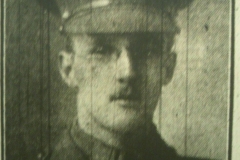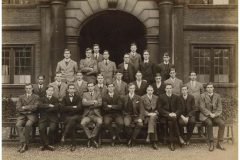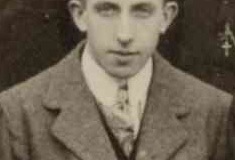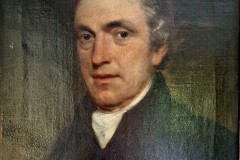Yorkshire Naturalists’ at War
Capt. Herbert Vincent Corbett (20.1.1893 to 17.10.1918):
Loss of a talented young scientist
Vincent Corbett of 3 Thorne Road, Doncaster, was the son of Dr H.H. Corbett, a founder of the Doncaster Scientific Society and the first Curator of Doncaster Museum 1910-1921. Like his father he was an enthusiastic naturalist frequently attending meetings of the Doncaster Scientific Society and Yorkshire Naturalists’ Union and publishing his observations and discoveries in the YNU scientific journal The Naturalist.
He attended Doncaster Grammar School (as an Exhibition scholar = attending on grounds of merit) and while at school held the honorary posts of curator of museum, Librarian, Magazine Editor, House Captain and Captain of the School. He went on to Cambridge University where at St. Catherine’s College he received a 2nd Class History Tripos. Being a member of the University Officer Training Corps, at the outbreak of War he, volunteered for active service and on 8 October 1914 was gazetted 2nd Lieutenant in the 1st Cambridgeshire Regiment (T.F.). The Cambridgeshire’s were then attached to the 11th (Service) Battalion of the Essex Regiment which after training at Aldershot, served with the British Expeditionary Force in France and Flanders reaching Saint-Polsur-Ternois and Etaples on 4 September 1915.
He was quickly promoted Lieutenant, but near Ypres in April, he was severely wounded in the shoulder and invalided home.
A year earlier (11-13 April 1914), as a care-free youngster, he was out on field work with the experts of the Yorkshire Naturalists’ Union surveying the banks of the river Nidd upstream of Knaresborough and publishing a list of his beetle finds in The Naturalist (Corbett 1914).
Vincent returned to Cambridge in June to take his BA Honours but, owing to ill health, was subsequently employed on home service.
During his convalescence he turned his attention to entomology, the YNU Annual report for 1915 noting “In the neglected order of Hemiptera [True Bugs] Lieut. H. Vincent Corbett is to be congratulated on the results of his studies, although severely handicapped by circumstances. Of the sixty-six species … collected in the Doncaster district during the year, twenty-three are new to Yorkshire. He has also paid considerable attention to the Homoptera [Aphids and Leafhoppers] … Several Ichneumons [parasitic wasps] have been added to the county list … observations have been made or specimens captured by … Vincent Corbett at Doncaster” (Butterfield 1916).
Also the Minutes of the Doncaster Naturalists’ Society record that “In Entomology, the best work has been done locally by Lieutenant H. V. Corbett during the time that he was unfit for military duty. He collected Hemiptera of our district chiefly in Wheatley Wood and at Rossington. The result was an addition of almost 30 species of interest to the Yorkshire list …”
On 2 September 1916, observations at an ant nest in a Doncaster garden [presumably at his home at 3 Thorne Road] Vincent encountered a single, later a group of worker Red Ants Myrmica ruginodis as they cooperated in overpowering and manoeuvring a relatively huge adult male Earwig Forficula auricularia into their underground nest, an operation which lasted from 5:20pm to 8:20pm. Careful notes were made of the sequences of manoeuvres, and of the attack and defence strategies employed by both participants. No doubt this interaction was viewed as a metaphor for the unequal skirmishes encountered on the Western Front (Corbett 1916).
On his recovery he returned to his regiment in France in June, 1918, being attached to the 11th Essex Regiment. He was killed in action during advances on Wassigny during the ‘Battle of the Selle’ on 17th October, just 25 days before the end of hostilities. He is buried in Bohain Cemetery, near Le Cateau (Anon 1918 and https://www.forces-war-records.co.uk/).
In addition to the personal tragedy, since Vincent was clearly a highly knowledgeable and talented entomologist, his death robbed the next generation of important scientific expertise. Fortunately, his published notes survive, and some of the insects he collected are still preserved in Doncaster Museum.
Below is Matthew Corbett (1763-1846), the great grandfather of Vincent, a builder of Pendleton, Manchester. The photo was generously offered to our Society by Rupert Fairclough, who is a great grandson of Herbert H. Corbett.
References:
Anon (1918) Capt. H.V. Corbett. The Naturalist 43 (1918): 340-341.
Butterfield, R. (1916) Yorkshire Naturalists’ Union Annual Report for 1915: Hymenoptera, Diptera and Hemiptera Committee. The Naturalist 41 (1916): 40.
Corbett, H.V. (1914) Yorkshire Naturalists’ at Knaresborough 11-13 April 1914: Coleoptera report. The Naturalist 39 (1914): 182-183.
Corbett, H.V. (1916) Fight between Earwig and Ants. The Naturalist 41 (1916) : 348-349.
Doncaster Naturalists’ Society Minute Book (Annual Report for 1916). DNS Archives, Doncaster Museum.
Websites: https://www.doncaster1914-18.org.uk/author/lynseys/page/5/
Websites: https://www.forces-war-records.co.uk/maps/units/182/essex-regiment/11th-service-battalion
See also : Commonwealth War Graves Commision https://www.cwgc.org/
Photo credits
- Doncaster Chronicle 7 May 1915
- St. Catherine’s College, Cambridge https://archivesearch.lib.cam.ac.uk/repositories/27/archival_objects/386893
- St. Catherine’s College, Cambridge (Crop)
- Rupert Fairclough (5 Oct 2025)
We appreciate being allowed to display the above photo from the Archives of St. Catherine’s College which featured the following freshmen for 1912.
K.C.J. Davies; ** J.W.I. M’Naught-Davies **; R.E. Livesey; A.G. Harvey; R.G. Howe; **G. Moore **; C.L. Corfield; A.L. Davies; B.P. Luscombe; J. Evans; V.R. Gunasekara; E.O.D. Baidarauaike; E.R. Woods; ** K.C. Gill **; G. Davison; W.O. Parish; H.S. Bates; R.H. Norby; ** A.C.J.K. Ryan **; E.P. Price; B.J. Wolfe; D.L.E. Davies; S.K. Chau; ** E.F.S. Preddy **; H. Webster; ** H.V. Corbett **; A.H. Wakefield; C.W. Kueen; G. Woodcock; G.B. Dempsey
(** Killed)
Colin Howes
Doncaster Naturalists’ Society – WW1 Research Project



